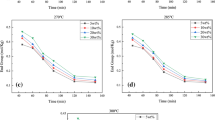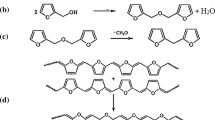Abstract
The pyrolysis of [4-(hydroxymethyl)phenoxymethyl]polystyrene (Wang) resin was studied by dynamic simultaneous thermogravimetric analysis (TGA) and derivative thermogravimetry techniques. The studied resin is used as the most commonly polymer supports in the peptide synthesis. A developed experimental master plots (exp-MP) model is presented that can be used to describe in more detail the pyrolysis of the resin established upon 4-hydroxybenzyl alcohol (PHB) on polystyrene, occurring throughout TGA experiments. This model assumes that the Wang resin is pyrolyzed through three parallel independent reaction steps, whereby their separation was performed through deconvolution procedure of the complex conversion rate curves. The mechanistic nature of each stage of Wang resin pyrolysis was explained by applying a combination of kinetic models such as diffusion mechanism, random nucleation and subsequent growth and chemical reactions mechanisms. The kinetic triplet parameters obtained in the present paper were then compared with those available in the literature. Within this kinetic study, the fraction distribution analysis (via distributed reactivity model) was performed, enabling reliable prediction of liquid products produced during the pyrolysis of the solid support of the Wang resin.
Graphical abstract


















Similar content being viewed by others
Availability of data and materials
The datasets generated during and/or analyzed during the current study are available from the corresponding author on reasonable request.
Code availability
Not applicable.
References
Dolle RE (2002) Comprehensive survey of combinatorial library synthesis: 2001. J Comb Chem 4(5):369–418. https://doi.org/10.1021/cc020039v
Felder ER, Poppinger D (1997) Combinatorial compound libraries for enhanced drug discovery approaches. Adv Drug Res 30:111–199. https://doi.org/10.1016/S0065-2490(97)80006-8
Blaney P, Grigg R, Sridharan V (2002) Traceless solid-phase organic synthesis. Chem Rev 102:2607–2624. https://doi.org/10.1021/cr0103827
Sammelsen RE, Kurth MJ (2001) Carbon-carbon bond-forming solid-phase reactions. Part II. Chem Rev 101:137–202. https://doi.org/10.1021/cr000086e
Früchtel JS, Jung G (1996) Organic chemistry on solid supports. Angew Chem Int Ed Engl 35:17–42. https://doi.org/10.1002/anie.199600171
Introduction of the databases “Solid-Phase Organic Reactions” (SPORE) and “ChemInform Electronic Journal” on CD-ROM. (1996). https://www.chemeurope.com
Caddick S, Hamza D, Wadman SN (1999) Solid-phase intermolecular radical reactions. Part 1. Sulfonyl radical addition to isolated alkenes and alkynes. Tetrahedron Lett 40:7285–7288. https://doi.org/10.1016/S0040-4039(99)01525-7
Seifert L (2000) Solid phase organic synthesis: investigation of resins and linkers for phenols. Thesis. Degree of Master of Science in Chemistry, Rochester Institute of Technology, New York, pp 11–14
Benoiton NL (2006) Chemistry of peptide synthesis. CRC Press Taylor & Francis Group, Boca Raton, pp 146–149
Kenzhin RM, Bauman YI, Mishakov IV, Zibareva IV, Vadyagin AA (2019) Conversion of polymer and resin wastes into the valuable products. JOJ Mater Sci 5(2):555660. https://doi.org/10.19080/JOJMS.2019.05.555660
Ayrilmis N, Özbay G, Kökten ES (2020) Properties of oriented strandboard produced using phenol-formaldehyde resin synthesized with bio-oil of lignocellulosic wastes. Mat Int 2(2):131–138
Almeida D, de Fátima Marques M (2016) Thermal and catalytic pyrolysis of plastic waste. Polímeros 26(1):44–51. https://doi.org/10.1590/0104-1428.2100
Zhi M, Liu Q, Chen H, Chen X, Feng S, He Y (2019) Thermal stability and flame retardancy properties of epoxy resin modified with functionalized graphene oxide containing phosphorus and silicon elements. ACS Omega 4(6):10975–10984. https://doi.org/10.1021/acsomega.9b00852
Ndolomingo MJ, Bingwa N, Meijboom R (2020) Review of supported metal nanoparticles: synthesis methodologies, advantages and application as catalysts. J Mater Sci 55:6195–6241. https://doi.org/10.1007/s10853-020-04415-x
Janković B, Manić N (2021) Kinetic analysis and reaction mechanism of p -alkoxybenzyl alcohol ([4-( hydroxymethyl ) phenoxymethyl ]polystyrene) resin pyrolysis: Revealing new information on thermal stability. Polym Degrad Stab 189:109606. https://doi.org/10.1016/j.polymdegradstab.2021.109606
Sronsri C, Boonchom B (2017) Deconvolution technique for the kinetic analysis of a complex reaction and the related thermodynamic functions of the formation of LiMn0.90Co0.05Mg0.05PO4. Chem Phys Lett 690:116–128. https://doi.org/10.1016/j.cplett.2017.10.045
Muravyev NV, Pivkina AN, Koga N (2019) Critical appraisal of kinetic calculation methods applied to overlapping multistep reactions. Molecules 24:2298. https://doi.org/10.3390/molecules24122298
Sronsri C, Noisong P, Danvirutai C (2016) Thermal decomposition kinetics of Mn0.9Co0.1HPO4·3H2O using experimental-model comparative and thermodynamic studies. J Therm Anal Calorim 127(3):1983–1994. https://doi.org/10.1007/s10973-016-5720-3
Koga N, Goshi Y, Yamada S, Pérez-Maqueda LA (2013) Kinetic approach to partially overlapped thermal decomposition processes. J Therm Anal Calorim 111:1463–1474. https://doi.org/10.1007/s10973-012-2500-6
Svoboda R, Málek J (2013) Applicability of Fraser-Suzuki function in kinetic analysis of complex crystallization processes. J Therm Anal Calorim 111:1045–1056. https://doi.org/10.1007/s10973-012-2445-9
Reece C (2017) Kinetic analysis and modelling in heterogeneous catalysis. PhD Thesis, Cardiff University, Cardiff CF10 3AT, UK, pp 1–231.
Miura K (1995) A new and simple method to estimate f(E) and k0(E) in the distributed activation energy model from three sets of experimental data. Energy Fuels 9:302–307. https://doi.org/10.1021/ef00050a014
Jung G (1999) Combinatorial chemistry – synthesis, analysis screening. Wiley, Weinheim, Germany, pp 488–490
Wang M (2018) Reductive cleavage of aromatic ethers by supported metal catalysts. Dissertation, Doctors of Natural Sciences (Dr. rer. nat.). Technical University of Munich, Chair II for Technical Chemistry, Germany, pp 7-16. (The dissertation was submitted to the Technical University of Munich on August 7th, 2018 and accepted by the Faculty of Chemistry on September 10th, 2018)
Yang M, Shibasaki Y (1998) Mechanisms of thermal degradation of polystyrene, polymethacrylonitrile, and their copolymers on flash pyrolysis. J Polym Sci A Polym Chem 36:2315–2330. https://doi.org/10.1002/(SICI)1099-0518(19980930)36
Kawamoto H (2017) Lignin pyrolysis reactions. J Wood Sci 63:117–132. https://doi.org/10.1007/s10086-016-1606-z
Peterson JD, Vyazovkin S, Wight CA (2001) Kinetics of the thermal and thermo-oxidative degradation of polystyrene, polyethylene and poly(propylene). Macromol Chem Phys 20:775–784. https://doi.org/10.1002/1521-3935(20010301)202
Kannan P, Biernacki JJ, Visco DP Jr, Lambert W (2009) Kinetics of thermal decomposition of expandable polystyrene in different gaseous environments. J Anal Appl Pyrolysis 84(2):139–144. https://doi.org/10.1016/j.jaap.2009.01.003
Westerhout RWJ, Waanders J, Kuipers JAM, van Swaaij WPM (1997) Kinetics of the low-temperature pyrolysis of polyethene, polypropene, and polystyrene modeling, experimental determination, and comparison with literature models and data. Ind Eng Chem Res 36(6):1955–1964. https://doi.org/10.1021/ie960501m
Arandes JM, Ereña J, Azkoiti MJ, Olazar M, Bilbao J (2003) Thermal recycling of polystyrene and polystyrene-butadiene dissolved in a light cycle oil. J Anal Appl Pyrolysis 70(2):747–760. https://doi.org/10.1016/S0165-2370(03)00056-1
Huang J, Meng H, Cheng X, Pan G, Cai X, Liu J (2020) Density functional theory study on bond dissociation energy of polystyrene trimer model compound. IOP Conf Ser Mater Sci Eng 729:012018. https://doi.org/10.1088/1757-899X/729/1/012018
Huang J, Cheng X, Meng H, Pan G, Wang S, Wang D (2020) Density functional theory study on the catalytic degradation mechanism of polystyrene. AIP Adv 10:085004. https://doi.org/10.1063/5.0013211
Tomar SS, Singh SP (2013) Catalytic thermolysis of polystyrene over hydrated laumontite and its kinetic analysis. Int J Curr Eng Technol 3(1):189–195
Zeng WR, Chow WK, Yao B (2007) Chemical kinetics and mechanism of polystyrene thermal decomposition. Conference: Proceedings of 7th Asia-Oceania symposium on fire science & technology, AOFST 7, Hong Kong, pp 1–11.
Achilias DS, Kanellopoulou I, Megalokonomos P, Antonakou E, Lappas AA (2007) Chemical recycling of polystyrene by pyrolysis: Potential use of the liquid product for the reproduction of polymer. Macromol Mater Eng 292:923–934. https://doi.org/10.1002/mame.200700058
Kim S-S, Kim S (2004) Pyrolysis characteristics of polystyrene and polypropylene in a stirred batch reactor. Chem Eng J 98(1–2):53–60. https://doi.org/10.1016/S1385-8947(03)00184-0
Kim Sang Y, Kim Seok Y, Kim Hyun S (2010) Investigation of thermodynamic parameters in the thermal decomposition of plastic waste – waste lube oil compounds. Environ Sci Technol 44(13):5313–5317. https://doi.org/10.1021/es101163e
Kuo S-W (2008) Hydrogen-bonding in polymer blends. J Polym Res 15:459–486. https://doi.org/10.1007/s10965-008-9192-4
Purcell KF, Drago RS (1967) Theoretical aspects of the linear enthalpy wavenumber shift relation for hydrogen-bonded phenols. J Am Chem Soc 89(12):2874–2879. https://doi.org/10.1021/ja00988a013
Cournoyer JJ, Krueger CA, Wade JV, Yan B (2004) The application of single-bead FTIR and color test for reaction monitoring and building block validation in combinatorial library synthesis. In: Yan B (ed) Analysis and purification methods in combinatorial chemistry. Wiley, Hoboken, USA, pp 55–57
Mora A-S, Tayouo R, Boutevin B, David G, Caillol S (2020) A perspective approach on the amine reactivity and the hydrogen bonds effect on epoxy-amine systems. Eur Polym J 123:109460. https://doi.org/10.1016/j.eurpolymj.2019.109460
Zhang S, Yang P, Bai Y, Zhou T, Zhu R, Gu Y (2017) Polybenzoxazines: thermal responsiveness of hydrogen bonds and application as latent curing agents for thermosetting resins. ACS Omega 2(4):1529–1534. https://doi.org/10.1021/acsomega.7b00075
Poletto M, Zattera AJ (2013) Materials produced from plant biomass. Part III: degradation kinetics and hydrogen bonding in lignin. Mater Res 16(5):1065–1070. https://doi.org/10.1590/S1516-14392013005000112
Tielens F, Gervais C, Lambert JFO, Mauri F, Costa D (2008) Ab initio study of the hydroxylated surface of amorphous silica: A representative model. Chem Mater 20(10):3336–3344. https://doi.org/10.1021/cm8001173
Baker EN, Hubbard RE (1984) Hydrogen bonding in globular proteins. Prog Biophys Mol Biol 44(2):97–179. https://doi.org/10.1016/0079-6107(84)90007-5
Zhou J, Lucas JP (1999) Hygrothermal effects of epoxy resin. Part I: the nature of water in epoxy. Polymer 40(20):5505–5512. https://doi.org/10.1016/S0032-3861(98)00790-3
Choi YS, Singh R, Zhang J, Balasubramanian G, Sturgeon MR, Katahira R, Chupka G, Beckham GT, Shanks BH (2016) Pyrolysis reaction networks for lignin model compounds: unraveling thermal deconstruction of β-O-4 and α-O-4 compounds. Green Chem 18:1762–1773. https://doi.org/10.1039/C5GC02268A
Li C-H, Zhang M-H, Jiang H (2009) Thermogravimetric kinetics of polystyrene degradation over BaO. J Chem Eng Chin Univ 23(1):171–174
Zhou J, Qiao Y, Wang W, Leng E, Huang J, Yu Y, Xu M (2016) Formation of styrene monomer, dimer and trimer in the primary volatiles produced from polystyrene pyrolysis in a wire-mesh reactor. Fuel 182:333–339. https://doi.org/10.1016/j.fuel.2016.05.123
Funding
The research was funded by the Ministry of Education, Science and Technological Development of the Republic of Serbia under Contract numbers 451-03-9/2021-14/200105 (N. Manić) and 451-03-9/2021-14/200017 (B. Janković).
Author information
Authors and Affiliations
Contributions
BJ contributed to conceptualization, methodology, software, validation, formal analysis, resources, data curation, writing—original draft, writing—review & editing, visualization, supervision, project administration. NM contributed to conceptualization, validation, investigation, writing—review and editing, and supervision.
Corresponding author
Ethics declarations
Conflict of interest
The authors declare that they have no known competing financial interests or personal relationships that could have appeared to influence the work reported in this paper.
Additional information
Publisher's Note
Springer Nature remains neutral with regard to jurisdictional claims in published maps and institutional affiliations.
Supplementary Information
Below is the link to the electronic supplementary material.
Rights and permissions
About this article
Cite this article
Janković, B., Manić, N. Pyrolysis kinetics of [4-(hydroxymethyl)phenoxymethyl]polystyrene (Wang) resin using master-plot method and distributed reactivity model. Polym. Bull. 80, 1915–1949 (2023). https://doi.org/10.1007/s00289-022-04159-5
Received:
Revised:
Accepted:
Published:
Issue Date:
DOI: https://doi.org/10.1007/s00289-022-04159-5




